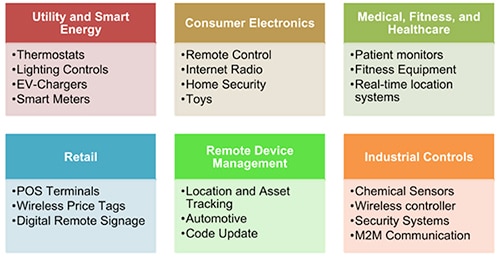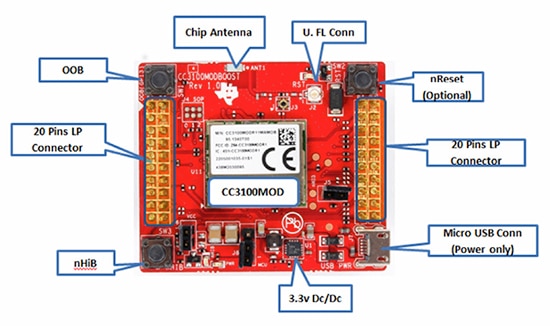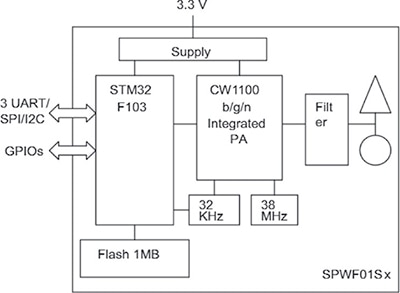The Current and Future Advantages of Using Wi-Fi Modules in IoT Designs
投稿人:DigiKey 北美编辑
2016-04-13
A ubiquitous Internet of Things (IoT) depends upon wireless connectivity, but there are many options for wireless and not every device is IP addressable – a requisite feature for IoT. What’s more, RF design is inherently difficult. Few companies are equipped with the appropriate skills to implement RF and antenna design, and even when done, keeping that design up to date with the latest standards and getting it through FCC compliance is time consuming.
For designers, there is a very solid and proven option for wireless connectivity and the IoT. That option is Wi-Fi and the use of modules. This feature will explain why, offer some design solutions, discuss soon-to-arrive upgrades to IEEE 802.11 protocols, and show how to bridge ZigBee to Wi-Fi for native IP addressability.
There are many wireless interface options, Bluetooth Low Energy (BLE), ZigBee, Z-Wave, Wi-Fi and RFID, each with their own unique balance of power, range, data rates, mesh networking, interference immunity, and ease of use. However, some interfaces are not yet native-IP enabled, so cannot be addressed directly or exchange data with other devices and servers over the Internet. These then require a separate gateway, adding expense and complexity to the final solution.
This is where Wi-Fi stands out: it is based on the IEEE 802.11 standards with native IP addressability, is ubiquitous, well understood, and can scale well in terms of data rates to optimize for power consumption. According to the Wi-Fi Alliance, there are more than 6.8 billion installed Wi-Fi-capable devices, so the odds are pretty high that there is a local Wi-Fi access point available (Figure 1). Note too that 802.11 standards are also IPv6 compliant, so there’s almost no limit to the number of unique addresses.

Figure 1: The wide range of IoT applications that use Wi-Fi modules shows the flexibility and scalability of the interface, as well as its ubiquity. (Source: Tektronix.)
While Wi-Fi is widespread and well understood, it is still a wireless interface, with all the vagaries of design that RF entails. Understanding next steps is critical.
Easing wireless development
After selecting Wi-Fi for an IoT application, the designer often faces the daunting challenge of building a custom RF implementation, which requires time, money and expertise. Design requirements for developing a wireless device include, at a minimum, direct RFIC integration and the ability to specify components such as filters, amplifiers, clocks, capacitors, inductors, crystal oscillators, and the antennas that need to be on the board, as well as their placement. There also needs to be network-matching circuitry to ensure that the radio and antenna are well matched to avoid signal loss. Other knowledge areas include system layout, software stack development, device security, connection reliability, signal interference and degradation, and last but surely not least, FCC certification.
How does this task get done within typical time to market parameters given that RF design expertise is not something readily available to every electronics company? An increasingly common way to add Wi-Fi capability is to use a pre-packaged module. This approach greatly simplifies the process. Modules are supplied tested, calibrated and pre-certified to the required standards by the module vendor, and therefore can provide companies with a fast, easy route to market with what is, essentially, a plug-and-play solution, reducing the need for software development. What is more, manufacturers who design and build the Wi-Fi modules can be your RF consultants during the design integration stage.
The Wi-Fi module generally contains two main parts: a Wi-Fi chip and an application host processor. The Wi-Fi subsystem includes an 802.11 radio physical layer (PHY), baseband, media access control (MAC), and perhaps a crypto engine for fast, secure Internet connection. The application host processor has internal or external flash, ROM, and RAM. The module generally also comes with I/Os for timers, serial communication interfaces, analog comparators, analog-to-digital converter (ADC), digital-to-analog converter (DAC), crystal oscillators, and a debug interface.
The power management subsystem includes integrated DC-DC converters supporting a wide range of supply voltages. It enables low-power consumption modes, such as hibernate with real-time clock (RTC) mode. A module may offer an integrated antenna or provide an RF connector for an external antenna. The software package included with a Wi-Fi module usually includes a device driver, an integrated 802.11 security layer, and a management and monitoring utility.
In designing a Wi-Fi IoT solution, the starting point is an understanding that IEEE 802.11 represents a family of standards that until just recently operated only in the 2.4 GHz (IEEE 802.11b/g/n) and 5 GHz (IEEE 802.11a/n/ac) unlicensed bands. There are three key factors to consider when evaluating these protocols: data rate, range, and power requirements. When you compare the different Wi-Fi protocols, 802.11b/g has the advantage in compatibility with installed devices and power requirements while 802.11n and 802.11ac have the advantage of higher data throughput for multimedia applications such as video streaming (see Table).
|
Table: A summary of different Wi-Fi protocols and data rates shows the progression of IEEE 802.11 from its early days of 2 Mbps to 1.3 Gbps today. (Source: Intel Corp.)
When designing for IoT applications, however, a higher data rate protocol is not always preferable. Even though 802.11ac can crank it up to a maximum of 1.3 Gbps, most embedded applications (e.g., machine to machine [M2M] data and control devices) are power constrained and can get by with a much lower data rate.
One more good reason to choose Wi-Fi is that within the next year or so technology upgrades will make it much more capable. For example, the Wi-Fi Alliance recently announced the Wi-Fi HaLow (pronounced "halo") designation for products incorporating IEEE 802.11ah technology. HaLow extends Wi-Fi into the 900 MHz band and offers improved range – nearly twice that of today’s Wi-Fi – with scalable data rates from 150 Kbps to 2.1 Mbps; IEEE 802.11ah also promises to provide low power consumption features and its use cases are primarily for wireless sensor networks, a classic IoT application.
In February, at the 2016 International Solid-State Circuits Conference (ISSCC) the Holst Centre of the Netherlands, in collaboration with Belgium’s IMEC Research Institute, showed a HaLow transmitter running Wi-Fi over sub-GHz bands. The team cited a maximum power consumption of 7.1 mW when delivering 0 dBm output power and operating from a 1 V supply. This represents a 10x power reduction compared to state-of-the-art 802.11 OFDM transceivers.
Also under development is IEEE 802.11ai, which will provide a fast initial link setup (achieving a secure link setup in less than 100 ms) and IEEE 802.11aq, being developed to provide a cellular-like automatic network-discovery experience.
Modules and dev kits
RF engineering can be a tricky business, especially for neophytes in the discipline. Recognizing this, RF silicon suppliers are providing modules, dev kits and reference designs that make adding wireless connectivity to a product much easier.
Microchip, for example, supplies an IoT development kit (DM990001) using a module driven by a 32-bit controller. It employs two Microchip components, the MRF24WG0MA/B pre-certified Wi-Fi module, which supports both 802.11b and 802.11g, and the PIC32MX695F512H microcontroller with 128 Kbytes of RAM and 512 Kbits of flash. The PIC MCU features an 80 MHz, 105-DMIPS 32-bit core, a USB 2.0 On-The-Go (OTG) peripheral with integrated PHY, a 10/100 Ethernet MAC, and four dedicated direct memory access (DMA) channels for USB OTG and Ethernet.
The starter kit is powered by Amazon Web Services (AWS), a managed cloud platform that lets connected devices securely interact with cloud applications. With AWS IoT applications can keep track of and communicate with all networked devices, all the time, even when they aren’t connected.
Amazon has put together Quickstart reference deployments for its AWS IoT, which is designed to show off some of the capabilities of the platform. AWS IoT can be especially helpful if you plan to use Amazon as your hosting provider. It supports HTTP, WebSockets for web browsers and web servers, and MQ Telemetry Transport (MQTT), a lightweight communication protocol for small sensors and mobile devices specifically designed to tolerate intermittent connections, minimize the code footprint on devices, and reduce network bandwidth requirements.
Texas instruments’ CC3100MOD Wi-Fi module is a complete platform solution including various tools and software, sample applications, user and programming guides, and reference designs (Figure 2). It consists mainly of the company’s CC3100R11MRGC Wi-Fi Network Processor and power management subsystems. Part of the company’s SimpleLink Wi-Fi family, CC3100MOD integrates all protocols for Wi-Fi and Internet, reducing host MCU software requirements. It also includes all required clocks, SPI flash, RF filter, crystal and passives.

Figure 2: TI’s CC3100MOD is designed to simplify the implementation of Internet connectivity. It integrates all protocols for Wi-Fi and the Internet, which greatly reduces host MCU software requirements.
The CC3100MOD Wi-Fi Network Processor subsystem incorporates an 802.11 b/g/n radio, baseband, and MAC and has a 256-bit encryption engine for secure Internet connection. It also contains a dedicated ARM MCU that completely off-loads the host MCU. The power management subsystem includes an integrated DC-DC converter with support for a wide range of supply voltages. It enables low-power consumption modes such as hibernate with RTC mode, which requires only about 7 μA of current.
On the software side the module includes embedded TCP/IP and TLS/SSL security stacks, HTTP server, and multiple Internet protocols. The device driver keeps the host memory footprint requirement to less than 7 Kbytes for code and 700 bytes of RAM for data for a TCP client application. The CC3100MOD IoT module solution is also FCC, IC, CE, and Wi-Fi certified.
The SPWF01S Wi-Fi module from STMicroelectronics is a plug-and-play 802.11b/g/n solution (Figure 3). It has a serial interface on one side that allows communications with MCUs like the supplier’s STM32 and STM8. On the other side is the Wi-Fi transceiver. The module also incorporates timing clocks and voltage regulators. It is available either configured with an embedded micro 2.45 GHz ISM band antenna (SPWF01SA), or with a U.FL coax connector for external antenna connection (SPWF01SC), so no RF knowledge is required for integration.

Figure 3: Block diagram of the ST SPWF01S serial-to-Wi-Fi b/g/n module. With low power consumption and a small form factor, it can be used for both fixed and mobile wireless applications.
The SPWF01S comes with CE, FCC and IC certification and meets industrial temperature-range requirements.
While we have focused on Wi-Fi, the ZigBee wireless standard is a popular choice for a wide range of applications that require low power, medium range, and flexible networking that is relatively easy to install, configure and maintain. ZigBee, however, lacks a crucial requirement for IoT applications: native IP connectivity. Digi International’s XBee® Wi-Fi modules bridge this gap. To get you started, the company’s XBee Wi-Fi Cloud kit (xka2B-wft-0) includes an XBee Wi-Fi (S6B) module, XBee USB development board with breadboard, a components package (resistors, relay, buttons, LEDs), access to Digi’s cloud-based application and all necessary antennas, power supplies, and cables. Digi’s XBee Wi-Fi modules share a common footprint with other XBee modules, which allows different XBee technologies to be drop-in replacements for each other.
IoT applications depend upon wireless connectivity, but there are numerous wireless protocol options. RF design also is inherently difficult and few companies are equipped with the appropriate skills to implement RF and antenna design. Even if the expertise is available, keeping the design up to date with the latest standards and getting it through FCC compliance is time consuming. This article has shown how Wi-Fi modules and their associated kits and reference designs can dramatically simplify the implementation challenges facing designers of new IoT devices.

免责声明:各个作者和/或论坛参与者在本网站发表的观点、看法和意见不代表 DigiKey 的观点、看法和意见,也不代表 DigiKey 官方政策。








 中国
中国